Each month V.D. Kaviraj answers questions about plants and plant problems. Kaviraj is one of the foremost pioneers of Agro-homeopathy and author of the book, Homeopathy for Farm and Garden.
The completely revised and enlarged edition with an additional 176 pages is now available:
Send your questions! (with pictures when possible – JPG or GIF format) to [email protected] with the subject “Plant Doctor”.
Note: When I refer to treating plants with homeopathic remedies, this is the standard dosing procedure: Put 20 drops of a 6X potency in a litre of water. Succuss the bottle 50 times. Put this litre in the watering can,fill it up with 19 litres of tap water and stir. If the watering can is smaller, the amount of remedy put in must be proportionally smaller. Thus a 10 litre can needs only ½ litre and just 10 drops of the remedy. Apply the contents of the watering can to the roots of the plants to be treated. –V.D. Kaviraj
Dear Sir,
I am staying in Kerala, Trissur district. I have a problem related to Nutmeg trees. Fruit of the plants fell off before ripe. I need a solution for this matter and good advice necessary for the well being of the trees.
Harikrishna Vadkedath
Dear Harikrishna,
I have the feeling that your trees may be in need of Pulsatilla or Phosphorus. My advice is to divide the trees into 2 groups and give either remedy to each group, to determine which will be the best. Please leave one tree untreated, so you have a control, as is demanded of any scientific investigation.
Next time, when the trees are flowering, it is advisable to spray all the trees with a dose of Silicea.
—————————————————————-
Respected sir,
I am Dr.Rangrajan from Karnataka, India ..We have pomegranate plants. Most of the plants are attacked by a fruit borer and some of the plants were attacked by fungal diseases. Please guide us sir. We had heavily fertilized last 9 yrs. Now can we suddenly shift to homeopathic remedies? Or do we need to slowly withdraw fertilizers? Please guide us sir.
Thank you
Dr.Rangarajan- Karnataka, India
Dear Dr Rangarajan,
The best remedy against the fruit borer is Thuja occidentalis. The plants will repel the insect after application of the remedy. As to fungal diseases, since you give no specific name, it is a little difficult to prescribe, but my best advice is the remedy Silicea. You have fertilised possibly with chemical fertiliser. It is better to use animal dung and specifically that of the cow, since it is the most balanced of all natural fertilisers. You can then leave out chemicals altogether. The cow provides you with the best fertiliser for free, so why would you pay money for a chemical substitute that does not remain in the soil but is washed out and needs repeated applications? Organic fertiliser will also reduce your water bill significantly.
—————————————————————-
Dear Dr Kaviraj,
Spectacular! My roses bushes were sick, all leaves yellow and brown. Following your book Homeopathy for Farm and Garden, gave Sulfur 5 CH and in 48 hours they came back green and alive. However I need your help to understand numbers.
When you say three applications 1st 500ml/500l per hectare or 10 ml/10l on small areas…. Is it 6 granules in water per 10 ml…? stir then pour the 10 ml in 10l of water then stir? I put 12 granules in a glass of water, stir – then I pour the glass of water in the watering can (20 L) – Was it correct ?
If correct, how many granules do you put in 500ml to pour in 500l for one hectare?
Sorry I am not good with numbers and get lost.
Thank you for your help.
Veronique
Dear Veronique,
10 ml is a liquid application. 10 ml is about a capful and this is mixed with one litre of water. I mention nowhere anything about granules, so I wonder where you get that idea. 500 ml, is half a litre of remedy, mixed with 500 litres of water.
—————————————————————-
Dear Kaviraj,
I live in Pennsylvania and am a gardner. Can you tell me what this is?
Lorie
Hi Lorie,
This is a Stramonium or trumpet flower. Its flowers are a potent poison. It produces unpleasant hallucinatory symptoms when consumed as a tea.
—————————————————————-
Hello Kaviraj,
I have a copy of your book, but thought you might be able to give me a more specific prescription if I showed you these pictures. The first 4 are of tomato blight – ‘early blight’. Does Silica seem like the best Rx? The last 2 pictures are of a squash bug – Anasa tristis – & its eggs. Should I make a 6x of the bug itself – or try the Syprh or Trop you suggest in the book?
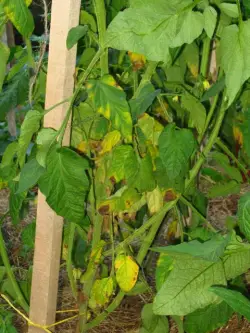
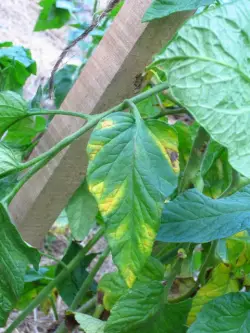
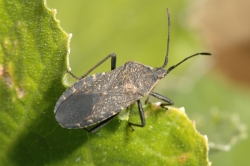
Thanks very much.
Julian Jonas
Julian Jonas, CCH, Lic. Ac.
Center for Homeopathy of Southern Vermont
Hi Julian,
Blight is best avoided by planting tomatoes away from potatoes, because they infect each other. The remedy Ferrum phosphoricum is the best to combat cases of blight.
The squash bug can be counteracted with Cantharis as the most appropriate remedy.
—————————————————————-
Dear Dr Kaviraj,
We have a young peach tree (8 yrs) in our yard that for 3 years has had this problem: the green leaves curl up, become red and then wither and the fruits remain small and wither too. What can I do?
Thank you very much
Claudio
Hi Claudio,
This sounds like you may have an insect that lays its eggs on the leaves and which then curls it to act as a protection of the pupae. There are bubbles seen in the red part of the leaves. I would say this is gall wasp. I would recommend Thuja as the most appropriate remedy.
—————————————————————-
Sir,
In the Mango Plant it is observed that the new leaves which have come now are getting cut in the middle of the leaves. Can you please inform me why this phenomenon occurs now in the rainy season? Are any insecticides to be used to prevent such problems in future?
Thank you,
C Radhakrishnan
I have no idea what you are talking about. Getting cut down the middle suggests to me that the central vein is split down the middle. That can easily be a nutrient problem, but it is hard to say which. Can you have a soil test done to determine pH and nutrient availability?

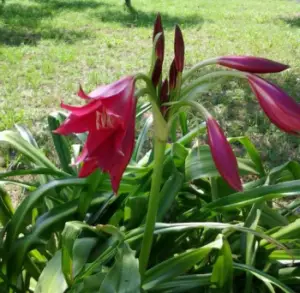

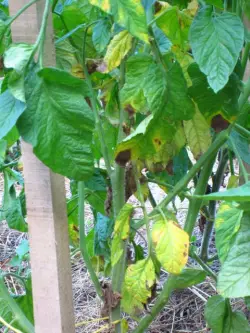


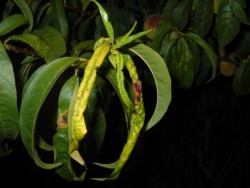
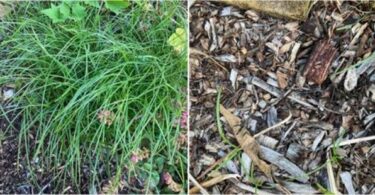


As always, your column is full of gems. I’ve appreciated especially your comment about cow dung being the best fertilizer because it is well balanced. Thank you, sir.
Please make available your book on Agro-Homeopathy available in India especially in Kerala. Some homeo doctors also try this homeo remedy in Kerala with variable success though not recognized. please continue the good work.
The best is to contact my publishers for that. I cannot “make it available” but they can.
Dr kaviraj there is no E book of your book ? Thanks.
This comment is related to problem of Harikrishna Vadkedath on fruit drop of nutmeg tree before ripening. May I add my experience of 40 years into plant research and specially in bilogical and hiodynamic agriculture. This problem is known as ‘Premature Fruit Drop’ and is basically caused due to hormonal imbalance, especially of auxin hormone. There are various causes of such imbalances. However, I would adavice Mr. Harikrishna Vadkedath to use any commercial preparation containing alpha Napthelic Acetic Acid (or NAA). One best known commercial preparation available in India is ‘PLANOFIX’. Spray 15 ppm or maximum 20 ppm solution and wet specially the peduncle joints, at berry stage. this will solve your problem.
Mr Pawan, this column is about agrohomoeopathy. It is not about promoting some commercial products, because the aim is to get away from these allopathic agricultural notions. It is not a “hormonal” problem, but a systemic one, in which the entire system in which the plant grows is out of balance.
You simply point out a SECONDARY RESULT of this systemic imbalance and present this as the “cause” of the premature fruitdrop.
My advise is to treat systemically and yours is to treat locally. You simply will create more disturbance, because you have not an integrated systemic view, but an allopathic fragmented view.
If you want to start a biodynamic page, ask the owners of this website for permission. Please do not start here giving advise to people, since that is my job and I have not appointed you as my assistant. You will only create confusion. Thank you very much.
May I add to your reply to Dr Rangarajan on switching over from chemicals to organic system or cow dung. My experience over 35 years into organic or biodynamic studies suggest that simply switching over to use of organic inputs, including cow dung, cannot really solve the pest or disease problem, but may reduce. One needs to understand the underlying sciences of organic farming. The crux of my life study is that:
1. Any thing that goes into your soil (including cow dung) should pass via ‘aerobically’ prepared ‘bio dynamic’ compost (which becomes disinfected having reached temperature of 65-70 deg. centigrade due to high biological activity).
2. Detoxify the soil (of long term chemical fertilize abuse) by using the above quality compost using at least three times in a year (mixed with the top soil – not to leave exposed on the surface). Over a period of three years, most of the disease and pest problem will reduce to zero, besides improving the soil quality, plant growth, production, quality and vitality of the plants.
3. Use of Bio dynamic preparation 500 and particularly 501 and the homoeopathy preparations suggested by Dr. Kaviraj.
If Dr. Kaviraj has no objection, I may share my long term experience of biological gardening and farming in this forum or you may also call on my cell 09331024566
First: Where did I say that switching to cow dung would solve pest and disease problems? Cow dung is simply better AND cheaper than chemical fertilisers – that is what I said.
I don’t think that the “science” of organic farming is something I need to be taught. One has to understand that organic farming is NOT A SCIENCE, but a natural way of growing food.
1. There is no need to pass anything through composting – where do you see such in Nature? Do the cows all pass dung in the same place and “scientifically” produce compost heaps? Nature is the teacher and Nature tells us what to do. To impose our ideas onto nature is exactly what has brought us in the present quandary. We need not “improve” Nature. That is the same mentality that has caused all the problems.
2. Nature is the teacher and Nature does everything effortlessly. To mix compost with the topsoil is to go against Nature. Where do you see Nature mix organic debris with the topsoil and disturb all the flora and fauna in the soil? Nature lets the flora and fauna work the organic debris into the soil and there is ABSOLUTELY no need to use any tools and disturb the topsoil. That is both unnatural and detrimental to the soil.
3. B500 is a good option, but rather than selling it, it is better to teach the farmer to make his own. If you want to start a biodynamics page, fine with me. But this column is about agrohomoeopathy and not biodynamics. As you can see from my comment, I disagree with the notions you present and so they would not fit in this column.
I teach farmers to become lazy farmers and let Nature do her work. There is no need for a plough, a spade, a fork, or other tool to disturb the soil. If you go into the forest, where does Nature disturb the soil by the use of tools? Where in the savannas does Nature plough? To disturb the soil is by the very nature of the disturbance already unnatural and detrimental. Let me teach mine and you can teach yours in your own space.
Thank you very much.
dr.,
Mr. Radhakrishnan has pointed out a case in which mango leaves are seen cut. It is not a nutrient problem but is due to a fly. I have seen it and usually do the work at night. These flies suck nutrients from the leaves through the cut it make
Dear Dr. Kaviraj,
Hello, Sir I would like to ask you abt. a disease in my TORI plant , its leaves are getting yellow spots which are increasing to all the leaves even now new leaves which are originating are with yellow pigments. Sir pls. suggest some medicine & how to use it.
Thanks a lot
Rajat
That sounds like it could do with a dose of Sulphur. How is the nitrogen situation in the soil? When in excess, sulphur is being locked up in the soil and the plant gets a deficiency. So then the remedy Sulphur will clear that up.
Dr Kaviraj,
Organic orchard – 13 years – of Avocados – Feurte and Hass culticars. Phytophtera infection, found in different stages over 200hectares. I know this is spread by water, but can manure from a feedlot ( i suspect the use of anti biotics causes a weaknes in the trees and soil, can this aggrivate the situation ) as natural fertilizer.
What treatment protocol would you recommend ?
My I use a broadpsectrum approach in treating the problem on a broadcacre basis ?
Carbo veg – Die back and weeping in some trees.
Silica – all infected trees shows the actual fungus on trees bark, leaves and roots.
Chamoimlla – weak and dying trees, no fruit production.
Calendula – antiseptic to trees ans soil. ( Tagetus patula as a companion plant or ground cover ?
Ferrum phos – for oxygen, and because water spreads the Phythotphera.
Potency 100D, 200C or 1M ? All mature trees, heavy infestation. 1 Treatment in root area ? Spray on leaves ?
Regards
Tommied
Hi Tommied,
Phytophtera is well controlled by Silicea. Of course you can do the experiment as you proposed. It will be interesting to see the results. I like the way you have looked at the remedies and you may have seen more than I did, when I studied and used them. I am always ready to learn.
Stink bug can be controlled by Cantharis – same family of Coleoptera.
Codling moth I would treat with Sambucus nigra or perhaps Thuja.
Cuprum met is very good for copper deficiency and is the prime remedy for such problems. You can also try Cuprum sulphuricum, which may be better under certain circumstances.
Thuja is also for tree cancers and cankerous growths, so that is a good choice.
We do not use remedies to kill anything – that we leave to the agribusiness fools. Everything has a function and we simply use remedies to make sure a fungus stays within its natural function or to control it when attempting to invade our food crops. If a fungus attacks grains, Ustilago is best indicated. I have not tried this remedy on any other plants than grains.
Dr Kaviraj,
Thansk for your help. Just to give more detail about some of the remedies, and please correct me if I have it wrong.
Calendula – I want to use this because of the trees that are under stress + as a tonic as growth is stunted when infected by Phytophtera. Is Carbo veg better indicated as a tonic for growth and low energy trees ?
Colour varies as infection varies and in different stages – Leaves go through different stages, yellow,orange brown, gray, black areas on trunk. Blackspot in some trees. Roots are black in colour and water uptake is low.
The problem we have is 34 000 Avo trees – with an infection rate of around 15% = 5100 trees more or less that is infected with Phytophtera. Most trees are 24 to 28 years old = 60% , trees age 14 to 22 years =30%, the rest is between 2 to 4 years of age.
Dr ask why Chamomilla – to correct the microbe life in the soil, part of the immune system of the soil that is out of balance and that increase Phytopthera in the trees. Will Chamomilla support the action of Silicea and
Graphites for weeping in trees ?
Silicea used only once around the roots ?
Flowering season in September to October – but season is late this year as winter in longer than normal. Can Silicea be sprayed once bflowering starts ? Will this support the Silicea action aplied to the soil ?
I have asked for compost to be tested for anti-biotic residue and to test for microbes. I will give feedback as we do the tests.
Regards
Tommie
PS: I noted that were radiation and electric pyllons are present, plants suffer. By spraying the areas with Gentian violet added to the water is gives protection against the negative energies of Cellular phione towers and elecrical grids.
Chamomilla serves that purpose better. This remedy is the best “tonic” for plants. If any plant is not doing well generally, Chamomilla will give it the necessary boost. It is also excellent in composting and the heat of the compost heap should eliminate all the antibiotics that are in there. Fungi do not generally survive 60-70 degrees Celcius temperatures, which is the normal temp in a good compost heap. Chamomilla will support bot Silicea and Carbo veg while Calendula is more for injuries and nematodes.
Carbo veg is for loss of vital fluids, as in drought conditions and for some stages in fungal diseases.
In the early stages of fungal disease, when they are yellow, orange or red, Aconite will do best, while in dark red rust, Belladonna is the better remedy. Black spot is treated most effectively with Sulphur.
Phytophtera generally responds very well to Silicea.
All remedies should be watered on the roots, with the sole exception of Silicea, which is sprayed over the whole tree during flowering only. As soon as flowering starts, you can apply this remedy. Otherwise it is also applied on the roots. The roots are the mouth of the tree and just as we do not use medicines on our heads or legs, except as topical applications, the same counts for plants. A topical spray of Silicea will not interfere with that which was applied on the roots. There is no reason to suspect a negative influence.
Interesting information about radiation and Gentian. Can you take photos of before and after that remedy?
Take care,
Kaviraj.
Dr Kaviraj,
I would like to know what your opinion would be on the following remedies to help with the Phytopthera infection in Avo trees.
Borax – Leave have uneven sides, some jagged edge – sawblade edge. White moulds on leaves. Brix 5 ( 8+ target). Stinkbug and False coddling moth end winter start of spring time.
Zincum – Leaves go through different stages, yellow,orange brown, gray, black. Blackspot in some trees.
Cuprum – very low levels of copper in leave analysis. High Fe/Iron in leaves. Balance uptake and to inhance uptake of available copper in soil.
Thuja – wart like growth on trees. As general insecticide. Bark becomes brittle. ( human toenails becomes brittle and causes ingrow toenails )
Usitilago – to stop and prevent fungus spreading. To kill or neutralize the spores in soil and plant.
Regards
Tommied
BTW, weeping in trees is better covered by Graphites.
Dieback I controlled in Australia with Silicea. Carbo veg may also do it, I don’t know.
The fungus for which you want to prescribe Silicea, what colour is it?
What you want to use Chamomilla for, I would use Phosphorus or Pulsatilla.
Calendula and Tagetes, I use to control nematodes. I don’t know it they are “antiseptic, as remedies, but I doubt it, as they do not work like that as plants either. Calendula is used for transplant wounds, but not as an “antiseptic”, which is a concept from allopathy and alien to homoeopathic thinking.
Ferrum phos is best in chlorosis, and has control over blight as a fungal disease. I have not used it as a general fungal remedy.
Trees can easily sustain higher potencies, but I would start with the 200C. If later you need to repeat, 1M and 10M can be used.
Regards and success!
Kaviraj.
Dr Kaviraj,
Thanks for your help and giving direction. I will take photos as we go along and report back on the effect of the treatment. Will see if I can put together a report on the progress – before, during, and after effects of remedies applied.
Regards
Tommie
Rest in Peace Dr Kaviraj. The world lost a great man. Your knowledge will be missed in future.
Dear Sir,
Your work is great…
Sir,How can I make the medium acidic for flowring plant like azalea. We get liquid dilution which contain alcohol.
As I studdied that ferrous sulfate is used to make the medium acedic but it actually take months to make the medium acidic. As i read in your blog about sulfer 5ch ; is it ok for flowring?
Sir, I have Emrald jade vine plant which is most rare and endangered but luckly I got it but its not growing; can’t show new shoots ..
Regards
Sir,
I have given cow dung at over doses in plant tab, and that why the leaf of those plant fall down heavily with yellow colour. So I want to know that what is the solution of it? Please help me.
Thank you
R. Auddy
Sir i am from Karnataka
Sir i jave pomegranate trees in 4 hects land
Sir this plants r dieing due to die back disease
Sir how can i control this disease please tell me wt to do for this disease to control .
Sir which homeopathic medicine used wilt and die back diseases in pomgranate
Please tell me sie